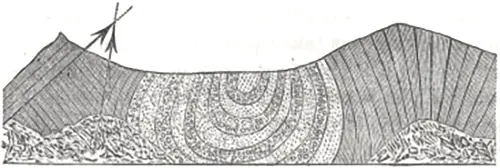[Originally published as the first half of Timeframes of Evolution]
Time is the fourth principle driving Charles Darwin’s theory of evolution, “by means of natural selection.” As with the other four principles, time — specifically, the timeframes of earth’s history — challenges Darwin’s theory of “slight, successive” changes.
The theory of natural selection is contingent on extended periods of time. In The Origin of Species, Darwin wrote:
I do believe that natural selection will generally act very slowly, only at long intervals of time.
Niles Eldredge at the American Museum of Natural History developed the V.I.S.T.A. acronym to codify Darwin’s theory. The “T” represents time, which is expressed in various ways, including intervals of time, timelines, timescales, timetables, and timeframes.
Scientifically validating Darwin’s “slight, successive” theory hinges on finding evidence of “long intervals of time” in earth’s biosphere history. Geology and biology are the foundational pillars of earth’s biosphere.
Without time, the universe would not exist. The fields of geology and biology hold the keys to understanding earth’s history of time.
This article examines the history and current understandings of popular evolution timeframes. The term timeframe is used interchangeably with modern concepts of timelines and timescales.
Natural Selection Time Constraint
Evolution is understood as a gradual process shaping earth’s enormous and diverse biosphere, unfolding over long periods of time.
While long time intervals are a theoretical necessity, finding evidence of these remained beyond Darwin’s reach to quantify. Darwin explains why:
“Unfortunately, we have no means of determining, according to the standard of years, how long a period it takes to modify a species; but to the subject of time we must return.”
Physical evidence for long periods of time is essential for the theory of evolution to have any scientific credence. Ironically, Darwin reasoned why the geological evidence seemed to be missing, in part:
The crust of the earth is a vast museum; but the natural collections have been imperfectly made, and only at long intervals of time.
On the principle of time, circular reasoning plays a role in understanding earth’s history. However, is the dilemma with the evidence or with Darwin’s theory?
Evolutionary theory is entangled with its dating methods. Over the centuries, the development of modern technologies and scientific methods has now provided a fascinating answer to Darwin’s dilemma.
Nineteenth-Century Geology

During his five-year voyage on the HMS Beagle, Darwin recorded detailed descriptions of rock formations, fossils, and living creatures. These included making drawings of the uplifted landmasses of South America, such as the one pictured above, that he later published in his Geological Observations in 1876.
As he traveled, Darwin’s observations were increasingly influenced by the emerging new concept of geology known as uniformitarianism. This concept posits that geological forces throughout earth’s history have remained relatively constant, resulting in only gradual changes.
Uniformitarian concepts deny the possibility of rapid, short-term, and massive events, such as the biblical flood in Genesis. Charles Lyell (1797–1875), Professor of Geology at King’s College London, encapsulated and further popularized the theory in the phrase “The present is key to the past.”
By logical reasoning, imperceivable gradual changes signify that earth’s crust must have developed over long periods of time.
Charles Lyell
Just before departing England in 1831, Captain Robert FitzRoy gave Darwin a copy of Lyell’s first volume entitled The Principles of Geology. The two sequel volumes, published in 1832 and 1833, were shipped to Darwin by his mentor John Henslow.
In the second volume, Lyell envisioned earth’s vast biosphere slowly emerging in the context of uniformitarianism, suggesting:
Each species may have had its origin in a single pair, or individual, where an individual was sufficient, and species may have been created in succession.
Lyell’s vision of gradual geological changes over vast periods of time influenced Darwin’s emerging concepts of biological evolution. Uniformitarianism logically aligned with Darwin’s emerging “long intervals of time” concept. In 1834, after returning from a river expedition, Darwin declared himself a “Lyellian.”
John Gould
During the same year, Darwin sent his fifth and last shipment of notes, drawings, and artifacts back to England for evaluation. Many were sent to the Zoological Society of London and examined by John Gould, the first curator of the museum.
After returning to England in 1836, Darwin and Lyell began corresponding frequently, a habit that they continued for decades. However, prior to 1855, none of these letters were about natural selection. Then, after reading a draft manuscript just one month prior to the publication of The Origin of Species, Lyell wrote to Darwin:
“It is a splendid case of close reasoning & long sustained argument throughout so many pages, the condensation immense, too great perhaps for the uninitiated but an effective & important preliminary statement which will admit even before your detailed proofs appear of some occasional useful exemplifications.”
For Lyell, while he respected Darwin’s “preliminary argument,” he concluded the logic was missing “detailed proofs.”
Ironically, Lyell’s concept was later recognized as lacking evidence, too. Lyell had built his theory on James Hutton’s theory, not “detailed proofs.” Ironically, while Lyell’s uniformitarian concept aligned with what Darwin needed, Lyell was a longtime skeptic of natural selection.
At one point, Darwin noted that his concepts “came half out of Lyell’s brains.” However, based on the geological evidence, Lyell remained skeptical of Darwin’s theory. In The Principles of Geology, Lyell wrote:
There is no foundation in geological facts, for the popular theory of the successive development of the animal and vegetable world (natural selection), from the simplest to the most perfect forms.
James Hutton
The concept of uniformitarianism was introduced by eighteenth-century Scottish geologist James Hutton (1726–1797). Earth, according to Hutton, was from an infinite past and continues into an infinite future, such that there is:
No vestige of a beginning, no prospect of an end.
Hutton proposed a continuous deep-time cyclical model of earth’s history without timeframes. He is often called the “father of modern geology.” Hutton’s seminal work, Theory of the Earth, appeared in 1795. At the time, Hutton and Lyell were the contemporary intellectual giants in geology.
However, earlier in 1759, Italian geologist Giovanni Arduino (1714–1795) introduced his geological model that ran contrary to Hutton’s uniformitarian theory.
Giovanni Arduino
In a pair of letters sent to fellow Italian naturalist, Antonio Vallisneri Jr., Arduino interpreted his observations of the Italian Alps. Rather than Hutton’s uniform timeframe, Arduino envisioned earth’s crust developing by distinct layers during episodic timeframes.
Arduino called these timeframes Primo Ordine (Primitive), Secondo Ordine (Secondary), and Terzo Ordine (Tertiary). In 1760, Arduino added his Quarto Ordine (Fourth Order), now known as the Quaternary Period.
Arduino’s timeframe concept eventually emerged as the foundation for modern stratigraphic classification systems. As the youngest layer, the Quarto Ordine appeared to be the result of a single cataclysmic flooding phenomenon — an unacceptable concept for Darwin. Abrupt environmental shifts are incompatible with slow adaptation and evolutionary continuity.
Darwin’s Time Search
By the nineteenth century, the earth’s crust was understood to be a composite of sedimentary layers. Older layers were covered by younger ones, a concept known as the Law of Supposition.
This concept was first introduced by Nicolas Steno (1638–1686). Steno envisioned the earth’s crust as a uniform accumulation of sedimentary layers. Arduino applied Steno’s concept a century later to develop his classification scheme.
In essence, Steno introduced the grammar of stratigraphy, while Arduino wrote a taxonomy of geological timeframes. While Arduino’s concepts undermined Hutton’s and Lyell’s uniformitarianism concept, they all inferred a degree of credibility for long periods of time — something Darwin’s theory desperately needed.
Darwin’s Time Study
To validate his time assumptions, Darwin independently performed a geological study in the Weald area of southeast England, already known for its unique ridge and valley formations ending in stunning chalk cliffs. Reporting his findings in the first edition of The Origin of Species, he concluded:
“…that for a cliff 500 feet in height, a denudation of one inch per century… At this rate, on the above data, the denudation of the Weald must have required 306,662,400 years; or say three hundred million years.”
However, Darwin never explained how he arrived at a calculated age of 300 million years for the area.
By the third and subsequent editions, Darwin deleted any references to his Weald time study calculations. Darwin increasingly recognized the perplexing nuances of geology, which conflicted with his theory of natural selection, noting:
“I allude to the manner in which species belonging to several of the main divisions of the animal kingdom suddenly appear in the lowest known fossiliferous rocks.”
Darwin’s Dilemma
This appearance of advanced life forms early in Earth’s stratigraphic history undermines Darwin’s theory; a conflict known as Darwin’s dilemma. Darwin recognizes this seemingly unresolvable geological dilemma, writing:
To the question why we do not find rich fossiliferous deposits belonging to these assumed earliest periods… I can give no satisfactory answer… the case at present must remain inexplicable.
However, Darwin remained steadfast, envisioning that gradual biological changes must somehow synchronize with geological changes over time.
To be continued…







